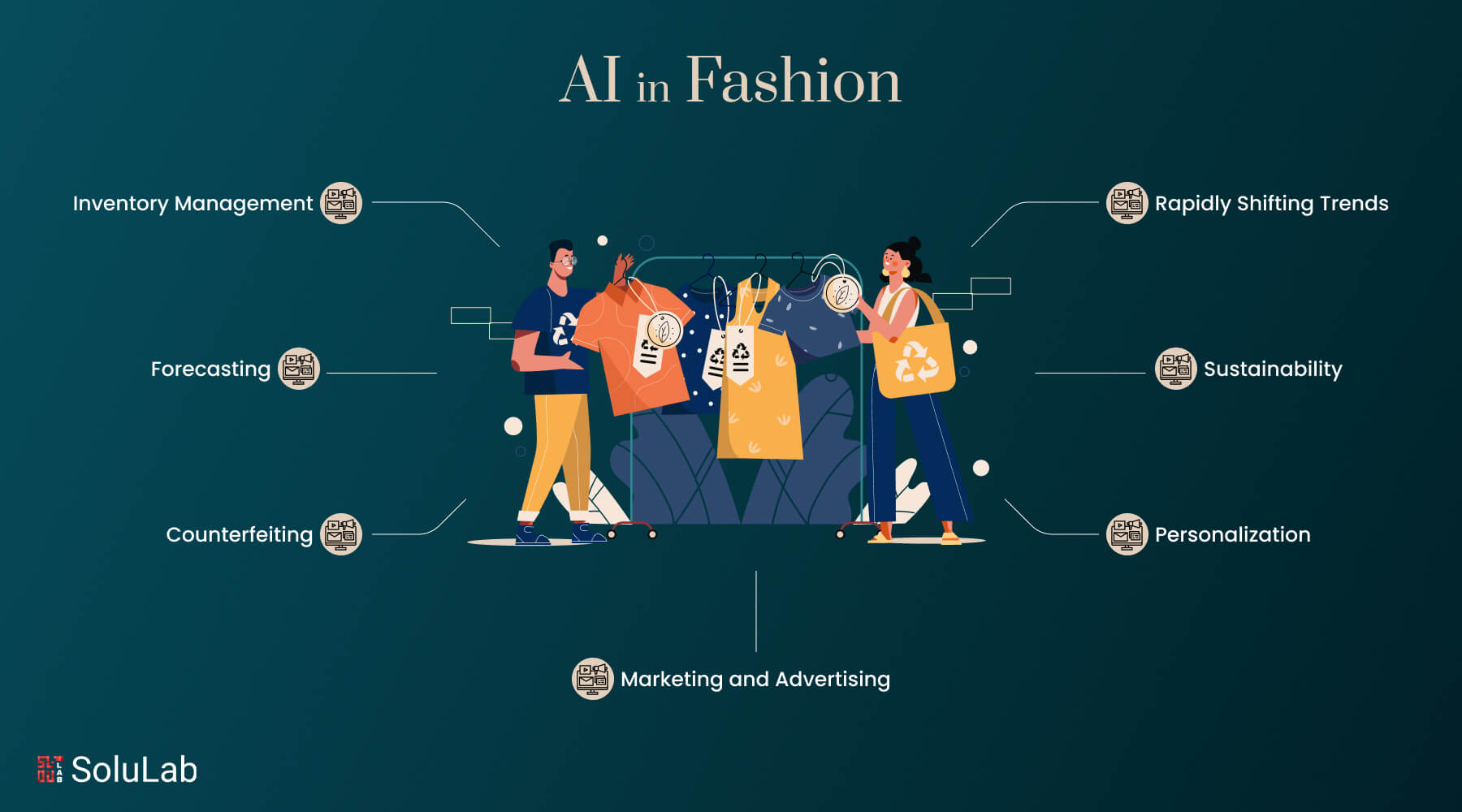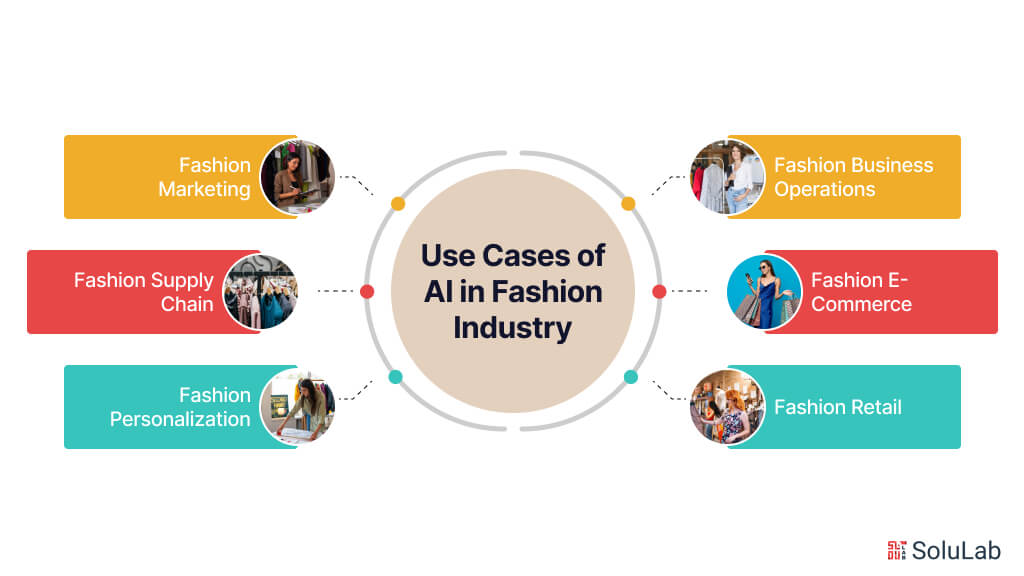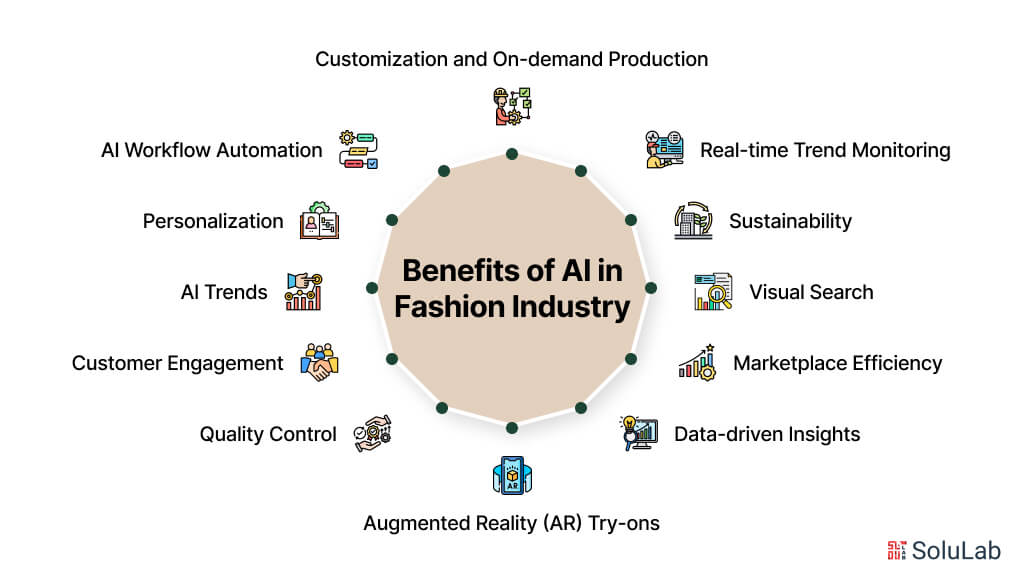
Artificial intelligence is a rapidly developing field that finds application in a wide range of sectors, including the fashion industry. AI is revolutionizing the fashion industry, influencing everything from garment design to customer choice prediction. AI is creating new opportunities for customers, merchants, and designers by analyzing large volumes of data and finding patterns.
Artificial intelligence (AI) is causing a dramatic shift in the fashion business, which has long been praised for its inventiveness and inventiveness. Fashion designers, businesses, and consumers are changing how they produce, sell, and purchase because artificial intelligence (AI) is becoming more than just a futuristic technology.
AI plays a wide range of roles in the fashion business, from supply chain optimization to trend prediction, providing previously unheard-of efficiency and insights. AI is revolutionizing the fashion industry by facilitating personalized shopping experiences, improving design processes, and advancing sustainability initiatives as the digital and physical worlds merge.
We will examine the several uses and advantages of artificial intelligence as we examine its revolutionary effect on the fashion business in this blog. We’ll also examine how AI-powered technologies are improving the creative process and giving designers new opportunities to experiment and push the limits of fashion.
Role of AI in the Fashion Industry
The style AI has made significant inroads into a variety of businesses, providing novel technology solutions, more effective operating procedures, and access to important consumer and industrial data. In today’s quickly changing world, firms that utilize the power of AI gain an edge on their competitors. Initially, AI automation did not attract the curiosity of fashion executives, who work in an industry that values creative expression. However, as we reach the hyper-digital age, AI applications have the ability to reshape fashion businesses, resulting in significant growth and revenue compared to those using traditional tactics.
In 2020, the use of Generative AI in fashion had become so pervasive that fashion companies who refused to accept it faced financial ruin. With a spectacular compound annual growth rate (CAGR) of 40.0%, the worldwide AI in fashion market size soared from $0.65 billion in 2022 to $0.91 billion in 2023. AI has a profoundly different influence on the conception, creation, marketing, and sales of fashion goods than just statistics. For example, AI-driven design tools help fashion designers anticipate customer preferences and come up with creative solutions. Automation powered by AI improves sustainability and efficiency in production.
Furthermore, fashion AI systems examine enormous volumes of data to enhance marketing plans and provide customers with a customized purchasing experience. It’s clear that artificial intelligence (AI) will continue to be extremely important to the fashion industry as we go forward.
The Prospects for AI in the Fashion Industry
The fashion sector has several issues that necessitate new solutions to remain competitive in today’s fast-paced world. Let’s look at the difficulties facing the fashion industry and how AI may assist in solving them.
- Rapidly Shifting Trends: Fashion trends shift at an unparalleled rapidity, making it difficult for designers and merchants to precisely forecast customer tastes. This uncertainty can result in overproduction, excess inventory, and waste.
- Inventory Management: Managing inventories efficiently is a never-ending task. Retailers frequently face stock outs or excess inventory, resulting in reduced revenue and financial losses.
- Personalization: Customers are increasingly looking for tailored experiences and products. Traditional methods of modification are laborious and costly, restricting their scalability.
- Sustainability: The fashion industry is coming under increasing criticism for its environmental effects. Waste reduction, the use of sustainable resources, and ethical production techniques are all important considerations.
- Forecasting: Effective demand forecasting is critical for production planning, but it is still a difficult undertaking owing to the numerous factors that influence customer behavior.
- Counterfeiting: Counterfeit fashion items cost the industry billions of dollars each year and destroy brand integrity.
- Marketing and Advertising: Reaching the correct target audience with efficient marketing tactics is a huge issue, especially in today’s digital age with various platforms and channels.
Artificial Intelligence in fashion has shown itself to be a creative force that can solve these problems. The fashion business may prosper in an increasingly competitive world by using artificial intelligence. Fashion companies can make data-driven choices, cut waste, improve customization, and stay ahead of trends by utilizing AI-driven solutions. Undoubtedly, style AI’s potential will have a significant impact on the fashion industry going forward, making it a vital instrument for its sustained prosperity.
Use Cases of AI in Fashion Industry

With its numerous applications and use cases, artificial intelligence (AI) has significantly penetrated the fashion sector. These fashion AI apps use machine learning techniques, data, picture identification, and natural language processing to improve a range of fashion industry issues. Here are a few well-known AI use cases in fashion:
Fashion Business Operations
1. Trend Forecasting and Buying: AI plays a crucial role in trend forecasting and buying by analyzing extensive data sources such as social media trends, historical sales data, and fashion blogs. AI algorithms analyze client tastes and habits patterns to anticipate future fashion trends. These insights enable fashion companies to make intelligent purchasing decisions for their forthcoming collections, ensuring that they are in line with current and growing trends.
2. Merchandising and Analysis: Effective merchandising is vital for optimizing sales and customer satisfaction. AI aids in optimizing inventory management and assortment planning by analyzing vast amounts of data, including sales data, historical trends, and customer preferences. This data-driven approach minimizes excess inventory, reduces out-of-stock situations, and enhances profitability for fashion businesses.
3. Design and Product Development: AI tools are increasingly integrated into the design and development process of fashion products. These tools generate design suggestions, optimize patterns for material efficiency, and create virtual prototypes of clothing items. Designers can experiment with different fabrics, styles, and colors to visualize the final product, streamlining the creative process and reducing design iterations.
4. Styling and Visual Merchandising: Visual merchandising, either in real stores or online, is the process of displaying things in an appealing manner in order to engage customers. AI helps by recommending style options and enhancing the overall visual appeal. By analyzing customer preferences and fashion trends, AI suggests how products should be styled or displayed, including recommendations for product combinations, outfit ideas, and virtual try-ons, providing customers with a compelling and personalized shopping experience.
Fashion E-Commerce
1. Product Recommendations: Personalized product recommendations are essential in fashion e-commerce to enhance the customer shopping experience. Style AI algorithms analyze a shopper’s browsing and purchase history to suggest products that are highly relevant to the individual. Such recommendations increase the probability of a purchase and nurture customer loyalty by showcasing an appreciation of the shopper’s unique style and preferences.
Related: Generative AI in E-Commerce Industry
2. Product Search and Discovery: Effective product search and discovery are critical in online fashion retail. AI-powered search engines improve the accuracy of search results and make product discovery more efficient. Techniques such as visual search and natural language processing (NLP) allow users to find products by uploading images, describing items in their own words, or using voice commands, creating a seamless and user-friendly experience.
3. Customer Service: Exceptional customer service is a cornerstone of successful e-commerce, and AI-driven solutions contribute significantly to this goal. AI-powered chatbots and virtual assistants are available 24/7 to handle customer inquiries, provide product information, and assist with shopping. These AI-driven chatbots can answer common questions, guide customers through the purchase process, and offer personalized product suggestions based on customer preferences, improving efficiency, reducing response times, and enhancing overall customer satisfaction.
Fashion Retail
1. Shop Floor Time Optimization: Managing staff schedules and tasks efficiently on the shop floor is crucial for retail operations. AI optimizes this aspect by analyzing historical sales data, foot traffic patterns, and other variables to help retailers allocate the right number of employees during peak shopping times, avoiding overstaffing during quieter periods.
2. Omnichannel Shopping: Today’s consumers expect a seamless shopping experience across physical and online stores. AI enables retailers to provide an omnichannel shopping experience by integrating physical and online stores, ensuring consistent product information, pricing, and promotions across various channels. This integration enhances convenience and fosters customer loyalty.
3. Virtual Reality: VR technology is redefining the fashion retail experience by enabling virtual try-ons. Customers can visualize how clothing items will appear on them before making a purchase, reducing the uncertainty associated with online shopping. VR technology creates a 3D representation of the customer, allowing them to “try on” different outfits virtually, leading to fewer returns and increased customer satisfaction.
Fashion Marketing
1. Retargeting Campaigns: AI enhances retargeting campaigns by analyzing customer behavior and preferences. AI creates highly targeted retargeting campaigns by understanding what products customers have shown interest in, displaying relevant ads to customers who have previously visited the website or engaged with certain products, increasing the likelihood of a conversion.
2. Loyalty Programs: AI systems analyze customer shopping history, preferences, and behaviors to offer tailored rewards and discounts. By personalizing loyalty programs, fashion brands can elevate customer engagement and foster a sense of loyalty, as customers feel appreciated and receive benefits relevant to their shopping habits.
Fashion Supply Chain
1. Supply Chain Optimization: In the fashion industry, efficient supply chain operations are pivotal, directly impacting cost and timely product delivery. AI is instrumental in refining these operations, allowing for the detailed analysis of diverse datasets, including historical sales, inventory levels, and external variables like weather and market trends. AI’s ability to synthesize such varied information enables enhanced inventory management and more precise demand forecasting, streamlining overall logistics processes. For example, style AI can strategically advise on inventory reordering to avoid stockouts or overstock situations, optimizing cost and ensuring product availability aligns with consumer demand.
2. Sustainability and Ethical Sourcing: Sustainability and ethical sourcing have become increasingly important in the fashion industry as consumers seek eco-friendly and ethically produced products. AI is essential to ensuring that fashion firms follow ethical and sustainable sourcing guidelines. AI-driven solutions can track and trace the supply chain, providing transparency to consumers concerned about the origins of the products they purchase. Artificial Intelligence can authenticate claims related to sustainability and ethics by using data from suppliers. It can also monitor factors such as fair labor practices, responsible sourcing of materials, and compliance with environmental regulations.
Fashion Personalization
n authenticate claims related to sustainability and ethics by using data from suppliers. It can also monitor factors such as fair labor practices, responsible sourcing of materials, and compliance with environmental regulations.
1. Personalized Marketing: Personalized marketing is a crucial strategy in the fashion industry, and AI is instrumental in achieving it. AI systems can analyze extensive amounts of customer data, including purchase history, browsing behavior, and demographic information. Using this data, AI can create highly personalized marketing campaigns. It adjusts marketing, suggestions for products, and content to each customer’s unique preferences. For example, AI can send personalized email recommendations, display targeted ads, and suggest products on a fashion brand’s website based on a customer’s unique style, past purchases, and interests. A level of customization like this fosters brand loyalty increases conversion rates, and improves customer engagement.
2. Customization: Fashion AI-driven platforms are redefining the fashion industry by allowing customers to personalize clothing items. These platforms leverage AI algorithms to enable customers to select from a vast array of customization options, such as selecting fabrics, colors, and designs and even adding personal touches like monograms or embroidery. Consumers can design distinctive, one-of-a-kind goods that suit their tastes and personal styles. AI ensures that the customization process is seamless and user-friendly, guiding customers through the design choices and providing visual previews of the final product. This improves the buying experience while satisfying the fashion industry’s growing need for uniqueness and self-expression. AI-powered customization promotes better customer happiness and product distinctiveness, which benefits fashion firms as well as their clientele.
Benefits of AI in Fashion Industry

AI has transformed the fashion industry, offering numerous benefits that have revolutionized the way fashion brands operate. AI-powered workflow automation has streamlined processes, reducing manual errors and increasing efficiency. AI trends in the fashion industry have enabled personalized recommendations, allowing customers to receive tailored fashion advice. Generative AI in fashion industry has also enabled the creation of customized fashion items, catering to individual preferences and measurements. Here are some of the benefits of Artificial Intelligence in fashion industry:
1. Personalization: AI’s ability to analyze customer data enables personalized fashion recommendations, increasing customer satisfaction and loyalty.
2. AI Workflow Automation: AI workflow automation has streamlined inventory management, design processes, and supply chain optimization, reducing waste and improving efficiency.
3. AI Trends: AI trends in the fashion industry have enabled personalized recommendations, allowing customers to receive tailored fashion advice.
4. Visual Search: AI-powered visual search enables customers to find similar fashion items more easily, enhancing their overall shopping experience.
5. Sustainability: AI-driven supply chain optimization and production processes reduce waste, improve energy efficiency, and promote sustainability.
6. Customer Engagement: AI-powered chatbots and virtual assistants provide 24/7 customer support, addressing customer inquiries and offering fashion advice.
7. Real-time Trend Monitoring: AI algorithms continuously monitor social media platforms and fashion forums, identifying emerging trends in real-time.
8. Customization and On-demand Production: AI enables customized fashion items based on individual preferences and measurements, reducing waste and addressing the demand for unique fashion pieces.
9. Quality Control: AI-powered quality control systems detect defects and inconsistencies during manufacturing, ensuring high-quality products.
10. Marketplace Efficiency: AI optimizes pricing strategies, adjusting prices dynamically based on demand, competitor pricing, and market conditions.
11. Data-driven Insights: AI generates valuable insights from customer data, informing marketing strategies and product development.
12. Augmented Reality (AR) Try-ons: AI-driven AR applications enable customers to virtually try out clothing and accessories, elevating the online shopping experience.
The benefits of AI in the fashion industry are vast and far-reaching. From streamlining processes to promoting sustainability, AI agents has become an essential tool for fashion brands seeking to thrive in a competitive market.
AI Technologies and Techniques in the Fashion Industry
The fashion AI industry has transformed operations, from design to consumer experience, by utilizing a range of artificial intelligence technologies and approaches. Here’s a comprehensive overview of the AI technologies and techniques commonly used in the fashion industry:
Machine Learning (ML) and Natural Language Processing (NLP)
AI in portfolio management enables fashion companies to analyze customer data, optimize product recommendations, and streamline inventory management. Here is how Machine Learning and Natural Language Processing (NLP) help in fashion industry:
- Image Recognition: ML algorithms identify patterns and objects within images, making it ideal for tasks like recognizing apparel styles, and colors, and detecting counterfeit products.
- Generative AI in Fashion Industry: Generative AI uses techniques like Generative Adversarial Networks (GANs) to create innovative fashion designs, styles, and even complete outfits.
Generative AI Use Cases in Fashion
- Style Transfer: Experiment with fashion design by applying the style of one fashion item to another.
- Deep Learning: AI-powered deep learning models analyze vast datasets, such as social media posts and influencer activities, to predict emerging fashion trends and early signals.
- Visual Search: Computer vision enables users to search for fashion items by uploading images or taking pictures. It analyzes the visual characteristics of products to find visually similar items, simplifying the search process for customers.
- Virtual Try-ons: Computer vision powers augmented reality (AR) and virtual reality (VR) applications that enable customers to virtually experience clothing and accessories before completing a purchase.
- Automated Authentication: AI algorithms detect counterfeit fashion items, ensuring authenticity in the market.
- Collaborative Filtering: These systems use customer behavior and preferences to recommend fashion items based on what similar customers have liked or purchased.
- Content-based Filtering: These systems recommend products based on the features and attributes of the items themselves, considering factors like color, style, and material.
- Chatbots and Virtual Assistants: AI-driven chatbots and virtual assistants provide real-time support, answering product inquiries, and assisting with purchases. They can also guide customers through the selection process based on their preferences and needs. Voice recognition is an emerging aspect of virtual assistants, enabling voice commerce.
These style AI technologies are revolutionizing the fashion industry, from machine learning and natural language processing to computer vision and deep learning. Generative AI is transforming the way we design and create fashion products, while AI-powered portfolio management optimizes business operations.
Future of AI in Fashion Industry
As AI technology advances, its impact on the fashion industry will continue to grow. Here are the key trends that will shape the future of AI in fashion:
1. Sustainable Fashion: AI will optimize supply chains, reduce waste, and improve efficiency to make fashion more sustainable and environmentally friendly.
2. Influencer Marketing 2.0: AI will analyze social media data to identify the most influential bloggers and personalities, helping fashion companies reach their target audience.
3. Trend Forecasting: AI will continue to analyze social media, runways, and street style to predict fashion trends accurately, allowing brands to stay ahead of the curve.
4. AI-Generated Designs: Designers will use AI to combine images of different clothing items, creating innovative and unexpected fashion designs.
5. Personalized Fashion Advice: AI-powered chatbots will provide customers with tailored fashion guidance, taking into account their body type, style preferences, and previous purchases.
As AI continues to transform the fashion industry, ethical and privacy concerns will need to be addressed.
Conclusion
AI has the power to completely transform the fashion business by boosting sustainability, increasing client experiences, and streamlining operations. The use cases of artificial intelligence (AI) in supply chain management, supply chain design, inventory control, customized purchasing, and predictive analytics show how this technology may open up new avenues and provide innovative services. Fashion retailers will maintain a competitive advantage, remain ahead of trends, and boost income if they adopt AI and invest in its development. Future trends in the fashion sector will be shaped by AI technology, which will become a vital tool for retailers as it develops and matures. As a result, fashion retailers need to embrace AI and make use of its potential to transform their business strategies, gain market share, and provide outstanding value to customers.
The adoption of AI in fashion is hindered by several challenges, including data quality and availability, lack of standardization, and the need for human oversight and validation. Additionally, AI solutions often require significant upfront investment and may not be scalable or adaptable to changing market trends. SoluLab can help overcome these challenges by providing customized AI solutions that leverage our expertise in data analysis and machine learning, ensuring high-quality data and accurate trend forecasting. Our team of experts can work closely with fashion brands to develop tailored AI solutions that meet their specific needs, and our scalable infrastructure can support the growth of the fashion industry. Are you ready to use AI technologies to optimize your fashion business? Contact AI experts at SoluLab to explore how we can assist and enhance your company processes with AI.
FAQs
1: What is the current role of Artificial Intelligence in the fashion industry?
Artificial Intelligence (AI) is currently being used in the fashion industry to optimize supply chain management, predict trends, and personalize customer experiences. AI-powered chatbots are also being used to provide customers with fashion advice and recommendations.
2: How can AI help fashion brands improve their sustainability?
AI can help fashion brands improve their sustainability by optimizing supply chain management, reducing waste, and improving efficiency. AI can also be used to analyze data on consumer behavior and preferences, helping brands to create more sustainable products that meet customer demand.
3: Can AI replace human fashion designers?
While AI can be used to generate designs and patterns, it is unlikely to replace human fashion designers entirely. Human designers bring creativity, intuition, and emotional intelligence to the design process, which are essential for creating unique and innovative designs.
4: How does AI help fashion brands understand consumer behavior?
AI can help fashion brands understand consumer behavior by analyzing large datasets of consumer behavior, including social media activity, purchase history, and search queries. This data can be used to identify trends and patterns in consumer behavior, helping brands to create more effective marketing campaigns and product designs.
5: What are the potential risks and challenges associated with using AI in the fashion industry?
The potential risks and challenges associated with using AI in the fashion industry include the need for high-quality data, the risk of bias in machine learning algorithms, and the need for human oversight and validation. Additionally, there may be concerns about job displacement and the impact on traditional design processes.






